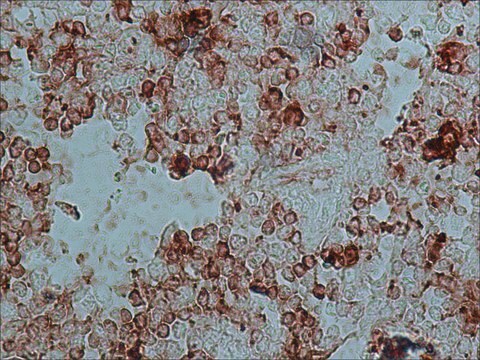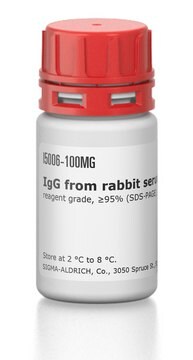R4880
Anti-Rabbit IgG (whole molecule) antibody produced in goat
affinity isolated antibody, lyophilized powder
Zaloguj sięWyświetlanie cen organizacyjnych i kontraktowych
About This Item
Polecane produkty
pochodzenie biologiczne
goat
Poziom jakości
białko sprzężone
unconjugated
forma przeciwciała
affinity isolated antibody
rodzaj przeciwciała
secondary antibodies
klon
polyclonal
Formularz
lyophilized powder
metody
immunoelectrophoresis: suitable
temp. przechowywania
2-8°C
docelowa modyfikacja potranslacyjna
unmodified
Szukasz podobnych produktów? Odwiedź Przewodnik dotyczący porównywania produktów
Opis ogólny
Binds all rabbit Igs.
Zastosowanie
Przeciwciało anty-Rabbit IgG (cała cząsteczka) produkowane u kozy jest odpowiednie jako przeciwciało drugorzędowe w immunoblottingu.
Zastosowania, w których z powodzeniem wykorzystano to przeciwciało, oraz związane z nimi recenzowane artykuły, podano poniżej.
Western Blotting (1 artykuł)
Western Blotting (1 artykuł)
Działania biochem./fizjol.
Podtyp przeciwciał IgG jest najobficiej występującą immunoglobuliną układu odpornościowego. Jest on wydzielany przez komórki B i znajduje się we krwi oraz płynach pozakomórkowych, zapewniając ochronę przed infekcjami wywołanymi przez bakterie, grzyby i wirusy. Matczyne IgG są przekazywane płodowi przez łożysko, co ma kluczowe znaczenie dla obrony immunologicznej noworodka przed infekcjami.
Inne uwagi
Przeciwciało adsorbowane z białkami ludzkiej surowicy.
Postać fizyczna
Liofilizowany z 0,01 M fosforanu sodu, 0,015 M chlorku sodu, pH 7,2
Rekonstytucja
Rozpuścić w 0,135 M chlorku sodu.
Oświadczenie o zrzeczeniu się odpowiedzialności
O ile nie określono inaczej w naszym katalogu lub innej dokumentacji firmy dołączonej do produktu(-ów), nasze produkty są przeznaczone wyłącznie do użytku badawczego i nie mogą być wykorzystywane do żadnych innych celów, w tym między innymi do nieautoryzowanych zastosowań komercyjnych, zastosowań diagnostycznych in vitro, zastosowań terapeutycznych ex vivo lub in vivo lub jakiegokolwiek rodzaju konsumpcji lub zastosowania u ludzi lub zwierząt.
Ta strona może zawierać tekst przetłumaczony maszynowo.
Nie możesz znaleźć właściwego produktu?
Wypróbuj nasz Narzędzie selektora produktów.
Kod klasy składowania
11 - Combustible Solids
Klasa zagrożenia wodnego (WGK)
WGK 3
Temperatura zapłonu (°F)
Not applicable
Temperatura zapłonu (°C)
Not applicable
Środki ochrony indywidualnej
Eyeshields, Gloves, type N95 (US)
Wybierz jedną z najnowszych wersji:
Masz już ten produkt?
Dokumenty związane z niedawno zakupionymi produktami zostały zamieszczone w Bibliotece dokumentów.
Klienci oglądali również te produkty
On-site quantification of human urinary albumin by a fluorescence immunoassay.
Sunga Choi et al.
Clinical chemistry, 50(6), 1052-1055 (2004-05-27)
M Rudling et al.
The American journal of pathology, 153(6), 1923-1935 (1998-12-10)
The high-affinity degradation of low-density lipoprotein (LDL) is enhanced 3- to 100-fold in leukemic blood cells from patients with acute myelogenous leukemia (AML), suggesting an increased cellular LDL receptor expression. There are, however, inconsistencies regarding the published properties of LDL
Jinsu Kim et al.
ACS applied materials & interfaces, 7(4), 2891-2898 (2015-01-13)
We demonstrated a lateral flow immunoassay (LFA) for detection of viruses using fluorescently labeled M13 bacteriophage as reporters and single-reporter counting as the readout. AviTag-biotinylated M13 phage were functionalized with antibodies using avidin-biotin conjugation and fluorescently labeled with AlexaFluor 555.
Shanshan Huang et al.
Pathology, research and practice, 215(4), 794-800 (2019-01-27)
Numbers of studies have indicated that miRNA-708 plays an important role in many types of cancer. However, the role of miRNA-708 in pancreatic ductal adenocarcinoma (PDAC) has yet to be fully elucidated. The present study aimed to investigate the role
Peter Engelhardt et al.
Methods in molecular biology (Clifton, N.J.), 369, 387-405 (2007-07-28)
Standard immunogold-labeling methods in transmission electron microscopy (TEM) are unable to locate immunogold particles in the depth direction. This inability does not only concern bulky whole mounts, but also sections. A partial solution to the problem is stereo inspection. However
Nasz zespół naukowców ma doświadczenie we wszystkich obszarach badań, w tym w naukach przyrodniczych, materiałoznawstwie, syntezie chemicznej, chromatografii, analityce i wielu innych dziedzinach.
Skontaktuj się z zespołem ds. pomocy technicznej










